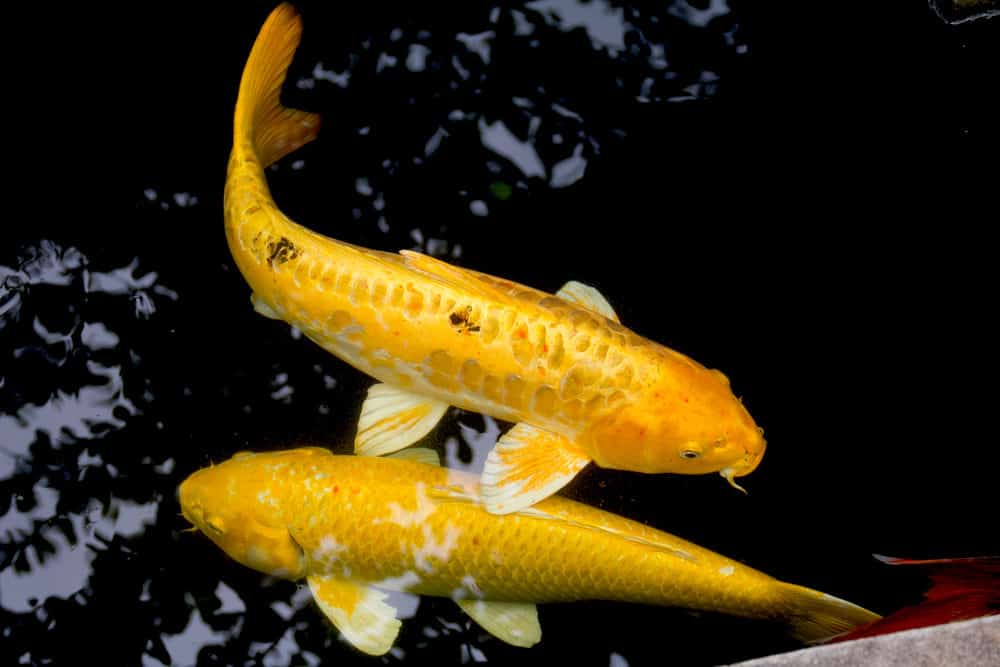We know how you feel: you saw a gorgeous koi fish tattoo on someone’s arm or a koi pond at a friend’s house, and you’re jealous. That’s why you’re here. You want to learn about koi fish, especially the beautiful bright yellow koi variety. Adding a koi pond to your property is a lovely way to upgrade your landscaping. After all, koi was originally bred in Japan specifically as an ornamental fish.

I’ve been a pond hobbyist for several years, and I do my research. Let me share what I know about yellow koi fish. In this article, we’ll take a look at:
If you’re looking for koi that have completely yellow coloration, get Hikarimuji koi (also called ogon). These koi have a metallic look, and each fish is just one color. Most Hikarimuji koi are either yellow ogon or platinum ogon. Pure yellow Hikarimjui koi are also called Yamabuki.
Other kinds of koi aren’t completely yellow but might have yellow or red markings combined with different colors.

Yellow koi is mainly prized for the beautiful look they give to a koi pond. Their bright color makes them visible from a difference, and they often have a cheerful and glittering look in the sun. If you want your koi pond to be primarily ornamental, yellow koi or red koi are for you. You can get a mix of different kinds of koi and make yellow koi one of the types you include.
If you're looking to add koi with yellow coloring to your pond, you can find koi fish farms and koi breeders in our helpful online directory. The directory will help you find koi stores near you - or order koi fish from an online serve.
You won’t have koi with a vibrant color if you don’t care for them the right way. Any deficiency in how you care for your pond fish is likely to dull its color.
Your koi fish need the right kind of pond, water quality, and koi food. Their environment (your pond) must be properly maintained to keep it healthy for fish.

The pond you create for your koi must have a minimum depth of four feet (preferably five or six feet) and needs enough length and width to allow adequate plant growth. Ensure you keep the water temperature consistent.
Ensure the water you put in your koi pond has suitable characteristics. If you use tap (or hose) water, you must dechlorinate and neutralize it first. Chlorine will lead to a dangerous situation for your fish. The water should also be free of nitrates and ammonia.
Water for a koi pond should range from 6.9 to 8.2. It should never be excessively alkaline or acidic.

If you chose yellow koi because of its vibrant color, you would be disappointed if you noticed this fading. If this happens, you should also be worried about your koi’s health and well-being. There are certain situations and conditions that can lead to loss of color in koi. Make sure that none of these problems are present in your koi’s environment. If you find any of them are, take steps to fix the problem.
Another potential cause is simple aging. If your yellow koi are fading because of this, you won’t be able to fix the problem.

If you got your yellow koi when they were young, you might find that the color slightly changes as they get older. You cannot assume that a koi will stay the same color for its whole life. If you have your heart set on only the brightest yellow koi that will never change color, you’re better off buying koi that’s already older.
One thing you can do to encourage a brighter yellow on your koi is to put it in cooler water. It has been found that koi living in cooler water develop a more vibrant color. This is because cooler water slows down the koi’s metabolism, and the fish will eat less. When this occurs, more pigment rises to the surface of the fish’s skin.
Koi keepers choose to give their yellow koi the highest quality food to encourage brighter coloration. If your koi carp are getting a low amount of any of the nutrients they need, their yellow color will be compromised.



